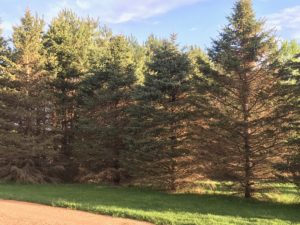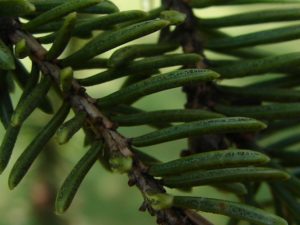
Spruce trees affected by rhizosphaera needle cast disease will have thin foliage in the lower parts of the tree, and branches may die in severe cases. Some trees are more susceptible, like the tree on the far left and the tree on the far right. Photo: Bethany and J.R. Pulham
By Linda Williams, forest health specialist, Woodruff. Linda.Williams@wisconsin.gov; 715-356-5211 x232
Are the lower branches of your spruce tree suddenly looking very thin? Rhizosphaera needle cast disease, caused by a fungal pathogen, can severely impact spruce, killing needles and causing them to drop prematurely. Wet years such as 2017 are great for the fungus, but bad for trees. Spring 2016 was also unusually wet, allowing the fungus to start to build up. With all the rain and wet conditions of 2017, the disease exploded.
Blue spruce trees are most commonly and most severely impacted. However, as 2017 was a banner year for the fungus, I commonly saw it on white spruce and even on Norway spruce, which is supposedly resistant to the disease. For rhizosphaera needle cast disease to take hold, needles need to be moist. In 2017, there was a lot of moisture present throughout the year, allowing for multiple infection periods. Since there is less wind activity and sunlight present at the bottoms of trees compared to the tops, moisture tends to persist on lower branches following a heavy dew or rain event. The bottom parts of trees are where we see the disease more commonly.

The black spots on these spruce needles are the fruiting structures of the Rhizosphaera fungus. They can be visible to the naked eye, although a hand lens makes it easier to see them as they are quite small. Photo: Linda Williams
How can you minimize the impacts of rhizosphaera needle cast disease? There are several things you can consider, depending on your situation. If you have just a few spruce trees in your yard, you may wish to spray them with an appropriate fungicide to protect from new infections. Fungicides need to be applied in the spring as foliage emerges. Information about fungicides can be found on the University of Wisconsin Extension’s rhizosphaera page. If lower branches are already severely impacted or dead, you can prune them off. Pruning the branches off the lower 6-8’ of the tree will increase air flow under the tree and help to keep the needles drier so there will be less infection. Finally, if just a few trees in a spruce stand/plantation are severely impacted, you should consider removing them as they will end up being infected the remainder of their lives.
Be sure to view the Forest Health News article this month on winter browning or winter desiccation, which can be mistaken for rhizosphaera needle cast disease and is affecting quite a few spruce trees around the state this spring.
